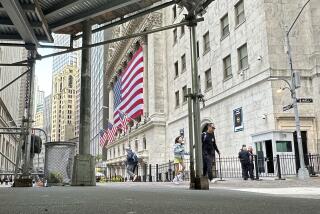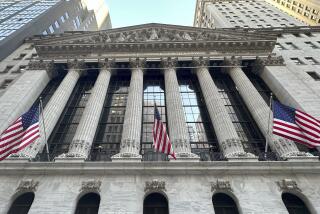Bulls Stampede in Bond Market and Small Stocks : Securities: A low inflation report is credited; bond yields hit a six-month low.
- Share via
Investors poured into Treasury bonds and small growth stocks on Wednesday, sending bond yields to their lowest level in nearly six months and boosting small stock indexes to all-time highs.
Bond traders described a rush of buying by large institutional investors after the government reported that inflation remained well under control in July.
Also, a report on disappointing early-August car sales suggested renewed weakness in the economy that could lead the Federal Reserve to cut interest rates again.
The result was a stampede into bonds and a surge in growth stocks that are expected to do well even in a slow economy:
* The yield on the Treasury’s 30-year bond plunged to 8.06% from 8.18% on Tuesday as demand for the bond soared, making it a seller’s market. The yield now is the lowest since Feb. 25, and was at 8.52% as recently as mid-July.
The decline in the benchmark 30-year bond yield could presage cuts in other long-term interest rates, such as on home mortgages.
* Yields on shorter-term Treasury securities also tumbled. The seven-year T-note’s yield fell to 7.66% from 7.73% on Tuesday.
* Smaller stocks jumped even though blue chips inched lower. The NASDAQ composite index of smaller issues gained 3.28 points to an all-time high of 517.68. In contrast, the blue chip Dow Jones industrial average slipped 3.35 points to 3,005.37, 30 points under its all-time high of 3,035.33.
Investors’ eagerness to lock in bond yields has increased markedly in recent weeks, as economic statistics have suggested the recovery that began in the spring is losing steam. Many bond traders now believe that the Federal Reserve is poised to push rates down in coming months to encourage business and consumer borrowing, thus stimulating the economy.
Last week, the Fed eased interest rates a quarter of a percentage point. Gary Schlossberg, economist at Wells Fargo Bank in San Francisco, believes that there is a “better than even chance” the Fed will cut rates again within weeks.
The bond bulls were cheered Wednesday by the July consumer price index report, showing a 0.2% rise. Over the past three months, inflation has run at a 3% annual rate. Many experts say that’s low enough to give the Fed room to ease credit without worrying about sparking too strong an economic revival that could boost prices on goods and services.
Even so, some money managers are concerned that bond yields have fallen too quickly in too short a period of time. They note that while U.S. rates have come down in recent weeks, Germany’s central bank appears intent on raising interest rates there--which could have reverberations in the U.S. bond market because money moves so easily around the globe.
Still, even if U.S. interest rates just stabilize, many experts say bonds remain attractive at their current 7% to 8% yields, compared to just 5.5% on money market funds and short-term bank CDs.
“If you take the basic scenario that the economic recovery will be a slow one, it’s hard to imagine what’s out there to push rates up,” says Donn Tognazzini, senior vice president at investment firm Starbuck Tisdale & Associates in Santa Barbara. “We think bonds continue to be a good value, particularly in relation to stocks.”
Other investors have a different idea, as evidenced by the surge in smaller stocks Wednesday.
“Analysts and portfolio managers are looking for companies that have strong earnings growth, and those companies are well-represented on the NASDAQ market” of smaller issues, said Stu Roberts, manager of the Montgomery Small-Cap stock fund in Denver.
Indeed, small stocks have led the market all year. As interest rates drop, many smaller companies are expected to benefit from lower interest costs.
In addition, lower returns on competing investments such as bonds increase investors’ willingness to pay more for stocks, on the chance that stocks will provide a far better return.
While IBM and other blue chip stocks in the Dow remained mired in recession, Roberts says he continues to find smaller firms that have quickly cut costs to match slower sales growth. The result is that those firms are able to keep their earnings on track, while larger firms struggle, he says.
Wednesday’s market highlights:
* On the New York Stock Exchange, gainers led losers 881 to 691, as volume remained heavy at 196.13 million shares.
* The small-stock surge was led by such growth issues as software firm Lotus Development, up 3 3/4 to 37 1/4; biotech firm Immune Response, up 2 3/8 to 15 1/2; restaurant chain Buffets Inc., up 2 1/8 to 35 3/4, and occupational health services firm TriCare, up 1 1/8 to 15 5/8.
* Bank stocks stabilized after jumping sharply in the wake of the BankAmerica/Security Pacific merger announcement Monday. BankAmerica was flat at 43 3/8, and Security was flat at 35 5/8. Among other banks and S&Ls;, Wells Fargo gained 1 1/8 to 77 5/8, First Interstate slipped 1/8 to 35 and H. F. Ahmanson added 7/8 to 20 5/8.
* Many retailers that have flourished despite weak consumer spending continued to advance. Wal-Mart jumped 1 5/8 to 51 1/2, Price Co. added 2 1/2 to 62 1/2 and Gap gained 1 1/4 to 42 7/8.
Overseas, Tokyo stocks advanced, as the Nikkei index gained 521.30 points to 23,393.30.
In London, the Financial Times-Stock Exchange 100 index jumped 23.9 points to 2,608.8. In Frankfurt, Germany, the DAX index added 5.47 points to 1,650.19.
In Mexico City, the Bolsa index rebounded from recent losses, gaining 27.30 points to 1,176.35.
Currency
The dollar finished higher against most major currencies as investors weighed the low July inflation report against an expected hike in German interest rates.
The low inflation figure boosted hopes of lower U.S. interest rates, which could weaken the dollar. But currency traders also expect that a rise in German rates--thought to be imminent--could dissuade the Federal Reserve from allowing U.S. rates to fall much further.
In New York, the dollar ended at 1.737 German marks, compared to 1.723 Tuesday. Against the Japanese yen, it closed at 136.70, up slightly from 136.45 Tuesday.
Commodities
Corn futures plunged, leading grain and soybean markets lower amid heavy selling by speculators who have lost hope for further gains this growing season.
Corn for September delivery settled 7.75 cents lower at $2.435 a bushel on the Chicago Board of Trade.
September wheat finished 5 cents lower at $2.96 a bushel; August soybeans settled at $5.385 a bushel, down 10 cents.
Unlike the soybean market, which collapsed in the past two weeks as drought conditions eased in the Midwest, corn prices have held up relatively well--until Wednesday, when traders gave up.
Elsewhere, light, sweet crude oil for September settled at $21.27 per barrel, down 31 cents, at the New York Merc. Unleaded gas for September settled at 66.31 cents a gallon, down 1.92 cents.
Gold and silver rallied modestly on New York’s Comex. August gold rose $1.50 to $357.80 an ounce; September silver rose 2.8 cents to $3.965 an ounce.
Market Roundup, D8
More to Read
Inside the business of entertainment
The Wide Shot brings you news, analysis and insights on everything from streaming wars to production — and what it all means for the future.
You may occasionally receive promotional content from the Los Angeles Times.










